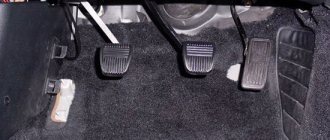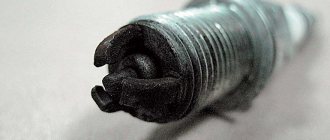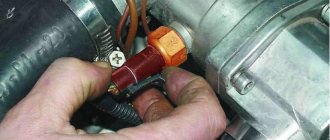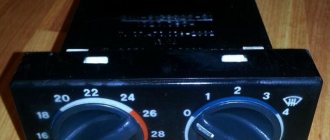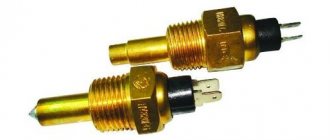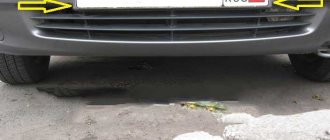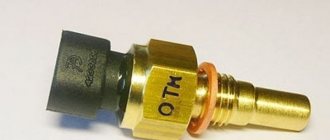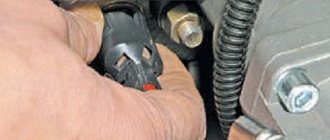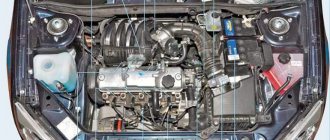As for the situation when the temperature sensor needle jumps and does not even allow you to approximately determine the indicators, in this case there has been a breakdown in the system. There may be several of them, so you need to be aware of all possible cases.
Most experienced drivers remember the importance of constantly monitoring engine temperature, because this data can tell a lot. Namely, to report possible problems in the cooling system and other malfunctions. If you notice this problem in time, you can minimize the damage and avoid costly repairs.
Very often, newbies behind the wheel neglect the importance of tracking these readings, but even experienced car owners are powerless if the temperature sensor needle jumps like crazy and does not allow them to correctly assess the situation. This is a good reason to diagnose the equipment, but regardless of whether you do it yourself or send it to a service center, any driver should understand the reason for this arrow behavior.
The engine temperature arrow jumps: why does this happen and what should the driver do?
Many drivers are well aware that constant monitoring of engine temperature allows timely detection of possible problems with the cooling system and protects the engine from overheating and costly repairs. For this reason, experienced car owners constantly pay attention to the internal combustion engine temperature indicator while driving a car.
In this article we will talk about why the engine temperature arrow rises, then the pointer drops, and also why the power plant temperature sensor may give incorrect readings, the engine temperature arrow floats while driving, etc.
Tips and tricks
Sometimes such non-standard behavior of the arrow can take even the most experienced drivers by surprise. But the most important thing in this situation is to behave correctly, so as not to accidentally aggravate the situation or solve it even before it occurs. Follow these tips to avoid serious consequences:
- If it was noticed that the needle is tending or is already at a high temperature level, then you should not immediately turn off the engine, but slow down (if you are in motion) and observe further changes. The temperature may normalize over time, but an emergency shutdown of the engine at a high threshold can be harmful to the engine and sensor. The only exception is when the needle is in the red zone for a long time.
- Check the amount of liquid in the tank on a regular basis in a timely manner. Don't let the level get low.
- Always monitor the quality of the liquid, both during purchase and during use. Any deviations from the norm (unpleasant odor, questionable color, etc.) must be accompanied by either diagnostics or fluid replacement.
- Keep the engine and cooling systems clean, avoid contamination and blockages.
- If the machine is very susceptible to frost, then take care that there is no internal icing, and that the machine is not left inoperative for a long time in the cold. Or use special insulation for the motor and other important parts.
If you follow these tips and be careful, you can prevent or notice problems in time, which will reduce the risk of serious breakdowns.
Also, treat such a situation with calm, this will help you better navigate, react and make decisions. So keep an eye on the needle and the engine will thank you.
The engine temperature arrow jumps, floats or jumps: causes and main malfunctions
So, normally the needle should rise to a certain value after the internal combustion engine has completely warmed up and not deviate from its occupied position. Note that during driving, small deviations are quite acceptable, and often to a lesser extent.
This phenomenon usually occurs in the cold season, often when driving on the highway. This is explained by the fact that in cold weather the engine is intensively cooled at high speed by counter flows of cold air.
Also, the heater takes away some of the heat from the engine in winter. As a result, the arrow may “fall” a little (by 2-3 mm from normal values). If you reduce the speed or allow the car to run at idle for several minutes, then the temperature gauge will rise to normal.
- First, in order to understand why the engine temperature gauge needle jumps, it should be taken into account that changing readings on the indicator do not always mean that in reality such significant changes in the temperature of the internal combustion engine occur.
In other words, a change in readings within the average range of 75-95 degrees does not reflect the actual picture, since heated coolant (antifreeze, antifreeze) cannot heat up and cool down so quickly. It turns out that the indicator does not display the actual engine temperature.
Otherwise, a smooth change in readings can be taken as the norm, making allowances for the conventional error of the dial or digital indicator itself. Moreover, if temperature fluctuations do not exceed acceptable limits, it is likely that this is the operating temperature of the engine.
A cause for concern is chaotic, usually sharp fluctuations of the needle, and the amplitude of such fluctuations is quite large. In this situation, it is necessary to determine whether there really is a violation of the thermal balance, whether the indicator itself is working normally, and also for what reasons the malfunction occurred.
- So, let's go. If the system is sealed and the coolant level in the expansion tank is normal, then the most frequently failing element, on which the engine temperature directly depends, is the cooling system thermostat. Moreover, this device often fails even on completely new cars with minimal mileage. So it’s better to start checking with the thermostat.
In practice, this manifests itself as follows: when the driver first warms up the engine, the temperature needle rises to operating temperatures, then the thermostat opens. Next, the coolant flows in a large circle, the engine temperature decreases, but then the thermostat jams and does not close completely.
Naturally, the liquid continues to flow partially or completely through the radiator (in a large circle). As a result, the engine begins to cool down and the temperature gauge drops. Then the thermostat will either close, after which the coolant will heat up to operating temperatures, or it will remain stuck in the jammed position and the engine will not warm up completely.
Attention - air
Finally, another possible reason for sudden movements of the needle is the presence of air bubbles in the antifreeze (“airing” of the system). Since the air and antifreeze have different temperatures, the needle jerks. An indirect sign of this malfunction is the splashing of coolant from the radiator cap or expansion tank, as well as a decrease in the filling volume.
To summarize, we can suggest the following order for checking the elements: contacts, ground, temperature sensor (DTOZH), thermostat, indicator board. Owners of Renault Logan should not dramatize the 2-4-2 display. This is normal thermostat operation.
PS In order not to upset Logan drivers, on the Duster and the second generation Logan-Sandero the temperature indicator on the dashboard was completely removed. As they say: no pointer, no problem.
Pilot85 » 06.01.2015 17:59
Re: Engine temperature gauge drops
mvb379 » 06.01.2015 18:59
Re: Engine temperature gauge drops
Pilot85 » 06.01.2015 20:14
Re: Engine temperature gauge drops
mvb379 » 06.01.2015 20:25
Re: Engine temperature gauge drops
Pilot85 » 06.01.2015 20:36
Re: Engine temperature gauge drops
Ursus » 10.01.2015 9:20
I have exactly the opposite problem. During warm-up (especially when it is warm and humid), the temperature needle goes up. if you work the air conditioner a little (about half an hour), it falls into place (just below the middle). At first I was very nervous, I thought all sorts of things, then I tormented him with ddl-reader - everything is very similar to normal behavior (at about 94 the cooler turns on, at 85 it turns off, the temperature does not rise abruptly, as the arrow on the panel shows, but gradually). The single-wire sensor (which goes to the panel) was changed and the contacts were cleaned. Suspicion about the tidy. By the way, take a look too, maybe one of the cables in the instrument panel has oxidized or broken. I wanted to wash the tidy in the fall, but I didn’t get around to it, and in winter it’s annoying to remove it - the plastic of the frame might burst. Another option is an ambush somewhere in the spit (short or poor mass). Well, if you find a reason, be a friend and unsubscribe.
- Related Topics Comments Views Last Post
- Dependence of engine speed on engine temperature andron812010 » 10/23/2016 9:56 in the forum Maintenance and operation 7 1149 andron812010 10/27/2016 17:54
- After warming up, the dynamics of AntiAuti drop » 09/29/2013 8:29 in the forum Maintenance and operation 2 1138 TAKH 09/29/2013 21:55
- Temperature sensor MixanM » 04/21/2015 21:07 in the forum Maintenance and operation 1 931 TAX 04/21/2015 21:40
- Fuel temperature sensor stas27rus » 12/19/2017 11:51 in the forum Maintenance and operation 14 1456 stas27rus 03/14/2018 15:22
- Air temperature sensor taranovskii1 » 05/06/2016 10:32 in the forum Maintenance and operation 1 1117 TAX 05/06/2016 11:11
- replacing the Adilet engine » 11/29/2017 10:03 in the forum Maintenance and operation 2,454 TAX 11/29/2017 17:09
- Replacing engine 1, 2max398 » 07/08/2016 13:19 in the forum Maintenance and operation 28 2183 Ronin 07/31/2019 9:31
The temperature needle jumps when the thermostat and DTOZh are working
In some cases, it happens that the thermostat, as well as the temperature sensor and wiring, turn out to be working. In this case, the temperature arrow jumps arbitrarily, overestimating or underestimating the readings, in an arbitrary range.
Often the problem lies in the electronic board of the instrument panel. If the soldering of such a board turns out to be of poor quality, problems arise after a few years. The malfunction can be eliminated by disassembling the shield and re-soldering. As part of such work, special attention should be paid to resistors and output mass. If you plan to do the work yourself, you need to have a low-power soldering iron with a thin rod.
As a result, the sensor reacts to changes in temperature, the pointer arrow changes position chaotically. At the same time, the air in the system is indirectly indicated by the fact that liquid is leaking from under the cap of the expansion tank, there may be a noticeable decrease in the level in the tank, etc.
I have contact
As electricians say, there can only be two faults: there is no contact where needed, or there is contact where it is not needed. This rule also applies in the situation under consideration. The arrow will jump if the joints are oxidized or weakened. Moreover, most often this happens when additional consumers are connected: low beam, headlights, etc.
As mentioned above, the first thing to do when diagnosing DTOZH is to check the contact in the connector. Returning to the previous section, the following should be added: if the sensor malfunctions, the readings fluctuate within the same range, and if they change chaotically, the wiring may be damaged. How important the negative contact is - the mass - will be confirmed by one case described by a forum participant.
The gauge needle sometimes jumped to 130°C. After stopping the engine, it showed the correct result - 90°. The voltage at the battery terminals when the engine was not running was about 12.5 V, and after starting it rose to 13.7.
After a year and a half of unsuccessfully searching for the cause, replacing the battery, alternator and two temperature sensors, I came across one grandpa who installed an additional ground wire from the engine to the body, and the problem was solved.
What's the result?
As you can see, there are not many reasons for the engine temperature gauge needle on the dashboard to start jumping or jumping. However, as part of the diagnosis, you should still use an integrated approach, eliminating possible problems one by one.
Finally, we note that the main thing is to make sure that the engine really does not experience overheating or completely reaches operating temperatures. To check this, you can connect diagnostic equipment, through which you can see the real temperature of the internal combustion engine. This approach will allow you to narrow down the range of potentially problematic elements and quickly find the fault.
How to understand that the engine has begun to overheat: obvious and hidden signs of engine overheating. Common reasons why overheating occurs.
The engine temperature does not rise, the internal combustion engine temperature needle drops while driving. Why does the temperature drop after turning on the stove? Diagnostics and repair, advice.
Why does the engine overheat? What should the driver expect and what damage may occur if the engine overheats. What to do if the internal combustion engine overheats.
The engine does not reach operating temperature, the engine temperature arrow does not rise during warm-up or falls while driving: causes of the malfunction.
The engine warms up slowly at idle or while driving: why does this happen? Possible malfunctions of the cooling system, other reasons.
Causes and results of diesel engine overheating. What to do if the diesel engine is overheating: diagnostics and troubleshooting. Important recommendations.
Source
FakeHeader
Comments 21
What happens when the temperature sensor turns off while the engine is running? The injection computer remembers the last value. It remains on the sign. As I said. He needs it to form a fuel-working mixture. For “every firefighter” he turns on the cooling fan. He doesn't know what the temperature is now, does he? This is one of the parameters. And an error message appears on the BC screen. You can’t stop the engine while it’s moving - something bad might happen. If the sensor is disconnected BEFORE STARTING the engine, then, as I assume, it will not start at all.
What happens to the fuel gauge, as I was told? The same. The last value remains on the pointer. So that the helmsman has something to focus on.
In both cases, the sensor values are read by the ECU and generate a signal to the temperature indicator or gasoline level in the tank.
Why the values can change and jump, I have some thoughts.
Guys, I don’t understand. Did you remove the chip from the sensor on the thermostat but the readings on the dashboard did not change? At the beginning of winter, my car was “underheated” according to the tidy and elm, but, as it turned out, the temperature sensor in the thermostat housing was the culprit. Or are you talking about some other sensor? Maybe it’s worth throwing in the instrument panel to try and see if it’s working?))
Yes, I wonder if it’s just like this for everyone or just me
I'll try to remove the chip today and take readings on the instrument panel
Even though it doesn’t coincide in the daytime to warm up the car and drop the chip. If it's still relevant, of course
Yes, it was business there for 5 seconds, I stopped, opened the hood and threw off the chip, but I warn you in advance that the error will remain in the memory and will not affect the operation in any way after returning and switching the car.
Ok, I'll get to work tomorrow morning and send it
I'll try to remove the chip today and take readings on the instrument panel
Do it better this way. — The engine is warm. The index has two or three divisions. To make it noticeable. — The engine is stopped. — You remove the connector. — Turn on the ignition. Ignition only! You can't start the engine. — Look at the temperature gauge readings.
If you try to start the engine, then, I think, it will not start. “Engine Failure Hazard” may pop up. Therefore, it is better not to try.
I’ll tell you why everything is like this in the last remark.
I have an LCD dashboard, two divisions. Here it is important to figure out where the signal comes from, from which sensor. I haven’t gotten to the car yet, the algorithm is clear. There is also an elm, I can look at changes in readings in it.
It doesn't matter what the pointer is. And you don’t need to figure it out. The signal to the pointer comes from the ECU. This is clear. ELM is completely unnecessary. Do as I said before.
In the recording you have the following parameters: - battery charge graphs (I don’t remember in what units), - mains voltage graph (all these parameters are in the engine block) These are one and the same thing. That’s why your launch seems like anything. And besides coolant temperature shows some engine temperature.
Yes, you need to try to remove the chip from the sensor on another car, can you?, the only downside is that the error will remain in your memory, and see if the level also does not change on the tidy. I agree with you about the rest, but when the gas level stopped working on a Zhiguli, it was immediately noticeable on the dashboard and you had to roughly estimate how long the tank would last, but there were Zhigulis, here everything may be different.
Let's return to our “rams”. Why are you doing all this? If you convince me it makes sense, I'll take part. So far I don't see the need for this. I must say that. Perhaps I was mistaken earlier when I said blocking the coolant access to the heater radiator.
I looked at the drawing, it seems to me that she always goes into it.
3 — heater radiator. How do I understand the coolant flows from it to the thermostat? When warming up, when the thermostat is closed, does coolant circulate through the heater core?
I didn’t understand anything about the Lada and the failure of the fuel level sensor.
I can barely navigate by the level indicator here. But, only “by eye”. Basically - bookmaker's data.
Here's another thing. I want to ask. You don’t like the changes in the position of the coolant temperature indicator arrow. Do you want stability? I understand it.
And here. What is your ultimate goal? What are you striving for besides the stability of the readings on the instrument panel?
You're in the wrong place again. I told you that the coolant temperature sensor is included in the injection ECU. And he talked about the method of measuring temperature. The sensor is a thermistor. Heating changes the resistance. The current flowing through it (thermistor) is measured. This is simplified. What the ECU controls and how is unknown. The readings on the temperature gauge are also provided by the ECU.
Normal engine temperature
For all previously produced cars (since 1992), the normal operating temperature of the engine was 90 degrees C. This value was generally accepted not only for Russia, but for the whole World, and all automakers were based on it in their standards. With the further development of automotive technology, it became clear that it is not always possible to adhere to the specified figure (especially due to the variety of engines and their systems).
As a result, at the newly held international congress, it was determined that the standard operating temperature for gasoline engines of all types will henceforth be considered the range from +85 C to +105 C. Any engine temperature within these limits is considered normal, but any, even small exceeding it to a greater extent is already overheating.
If we talk about Lada cars, including the 14th model, then the normal operating range will be a temperature from +87 to +103 C. This interval is the most optimal both in terms of performance and engine load.
If the temperature in the engine drops below the specified norm, the car will lose power and acceleration dynamics. If the temperature goes beyond the upper limits, the engine can boil and suffer significant damage (long-term driving with a boiling engine can threaten not only its serious damage, but also wear and tear on the units adjacent to it).
Cooling system problems
If you notice that the operating temperature of the VAZ 2114 engine does not correspond to the norm (both up and down), then first of all the reason should be looked for in the cooling system.
Its most important components that directly affect engine temperature are:
Thus, the first thing to check when the engine overheats is the radiator.
There are only 3 main reasons why it may not function correctly:
- Lack of coolant in the system.
- Cooling grid clogged.
- Leak.
In the first case, you should check the fluid level and, if necessary, top it up. In the second case, you will have to dismantle the radiator and clean it (both internal and external purging). In the third case (if a leak is detected), you can either use soldering or use a special sealing compound for radiators, and then add coolant to the normal level.
In some, especially advanced, cases, a complete replacement of the radiator may be required. It is not worth saving and trying to restore a “dead” radiator, since its incorrect operation can lead to severe wear and even damage to the engine, as a result of which a major repair will cost a much larger sum.
The next thing you have to check when troubleshooting is the cooling system pipes. With prolonged use, they can become “obsolete” with the further formation of cracks, which may result in a leak of coolant. If it turns out that the pipes have indeed leaked, they should simply be replaced with new ones, and the problem will be solved.
If it turns out that both the radiator and the pipes are working properly, you should check the pump (liquid pump). This can be done by replacing it with a new one of a similar model. If after such a replacement the operating temperature of the VAZ 2114 8-valve engine returns to normal, then this means that this was the reason.
How to test
You can check the serviceability of the sensor yourself. To do this you need to remove it from the car.
Here you need to follow the following algorithm:
- According to safety precautions, before removing this element, you need to let the engine cool to 40-50 degrees;
- remove the negative terminal from the battery;
- Disconnect the special connector from the measuring device to which the wires fit;
- at the last stage, all that remains is to unscrew the DTOZH using a key of a suitable size.
To carry out the test you will need the following instruments and materials:
- multifunctional tester with which you can measure circuit resistance;
- thermometer that measures temperatures up to 100 degrees Celsius;
- a glass or other container into which you can pour water.
The check must be carried out according to the following scheme:
- use a multimeter to check the resistance of the thermocouple;
- then immerse the sensor inside a glass of cold water and record the readings;
- monitor changes in resistance, gradually adding hot water - normally it should decrease, but if this does not happen, then you need to buy a new DTOZH temperature meter (this is not difficult to do, since the sensor is inexpensive).
